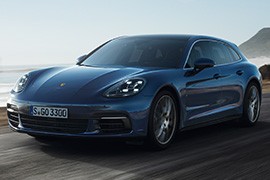PORSCHE Panamera 4S Diesel Sport Turismo Models/Series Timeline, Specifications & Photos
First production year: 2017
Engines: Diesel
Body style: Wagon (station wagon, estate, combi, touring)
Porsche surprised its fans in 2017 when it introduced the Panamera Sport Turismo at the Geneva Motor Show since the new vehicle was a shooting brake, which sported an unusual shape for this brand.
The German sports car maker was mostly known for the 911 lineup that was produced for decades. But that was not enough to help the brand survive and evolve, so it had to expand its range. After the Boxster, Cayenne, and Panamera, the carmaker’s fans were in for a shock again in 2017 when Porsche unveiled a station wagon version of the Panamera. But it wasn’t styled like a regular grocery getter; it had a shooting brake shape and was powered by the same engine range as the liftback sedan Panamera, and that included a turbo diesel version that was very appreciated in Europe thanks to its fuel efficiency.
Porsche didn’t start from scratch when it made the Panamera Sport Turismo. It started from the same platform used by its four-door sedan and redesigned parts of the bodywork and interior. As a result, the front fascia was similar to the one featured on the 2016 Panamera. It featured the same flush headlights that sported four LED blocks for the daytime running lights and LED headlamps. In addition, the lower bumper got a similar apron with a broad grille in the middle flanked by a pair of scoops, all crossed by two horizontal slats. The most significant difference was in the car’s profile.
The automaker extended the roofline of a regular Panamera and redesigned the rear doors. Moreover, it added a third row of windows between the C-pillars and the tailgate. To create a shooting-brake image, the Sport Turismo featured blackened B- and C-posts, and the entire window line was surrounded by a chromed trim. Finally, at the back, the automaker made a raked-forward tailgate adorned by a fat roof spoiler at the top. The taillights looked like a red strip that crossed the car from side to side, wrapped around the rear quarter panels and running underneath the rear window. Underneath the bumper, the automaker installed four exhausts that flanked the diffuser.
Inside, Porsche knew that it had to provide customers with a high level of elegance and comfort. At the front, it installed a pair of sports bucket seats with tall seatbacks and integrated headrests. The driver fronted a mixed instrument cluster where an analog tachometer took center stage and was flanked by two seven-inch screens designed to look like dials. But the biggest difference compared to the regular Panamera was in the back, where the automaker installed a split-folding (40/20/40) bench seat that could expand the trunk space. With the rear seats out of the way, the luggage compartment reached a whooping 1,390 liters (49 cu-ft) of space.
Under the hood, the German sports car maker didn’t go for the 3.0-liter V6 turbo diesel, which it offered in the Cayenne, but it chose a twin-turbocharged 4.0-liter V8. This powerplant developed 422 PS (416 hp) and a massive torque that was sent in all corners via an eight-speed automatic transmission. Besides performance, this version provided a range of over 1,000 km (621 miles).
